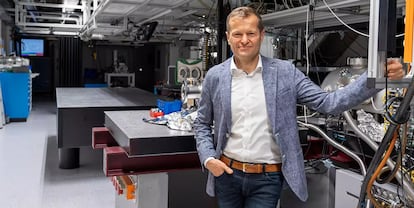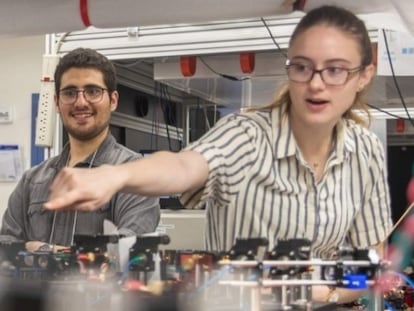Ferenc Krausz, winner of the Nobel Prize in Physics: Many types of cancer have ‘a very distinctive infrared light signature’
The Hungarian physicist is using attosecond science to try to detect malignant tumors in such early stages that it becomes much easier to cure them

Like the astronaut Neil Armstrong when he set his left foot on the Moon, the physicist Ferenc Krausz was the first person to peer into an unknown world: the realm of electrons, the elusive particles that act like glue for all known matter. In the early hours of September 11, 2001, at around 5 a.m., Krausz’s team managed to produce ultrashort laser light pulses of 650 attoseconds (an attosecond is a billionth of a billionth of a second). For the first time, humanity had achieved a flash of light so fleeting that it produced a “photograph” of the movement of electrons. But the physicist did not have time to savor his own success. “When I came back to my office and opened my computer, I saw these terrible images about the World Trade Center being destroyed by these terrorist attacks,” he recalls via video conference.
The Hungarian scientist, born in the wine-growing town of Mór 61 years ago, has won this year’s Nobel Prize in Physics. Krausz is one of the four directors of the prestigious Max Planck Institute of Quantum Optics in Garching, Germany. There, his team is searching for applications for their attosecond camera. In February, after winning the BBVA Foundation’s Frontiers Award, he predicted what the first real-world application will be: detecting cancer in such early stages that it will be easy to cure.
Question. How do you intend to detect cancer so early?
Answer. Attosecond technology was created to capture the movement of electrons on this timescale, but, in parallel, it also turned out to be very useful for capturing another phenomenon: the oscillations of the electric field of light. Basically, we take a very short pulse of infrared light and focus it on a human blood sample. Or, rather, blood plasma, because the cells have been removed, only molecules remain. It’s not even red, because the red blood cells have been removed first. It has a yellowish color and contains hundreds of thousands of different molecules. In medicine, it is known that, in a healthy organism, the concentration of these molecules falls within a very narrow range. Some of these molecules are already used in routine laboratory analysis that measure their concentration and compare it with the reference ranges in healthy people. This is very useful, but fails to provide a complete picture of your health status. Many diseases do not have a biomarker, or at least it has not been discovered.
Q. Not yet.
A. That is why there is a gigantic biomarker research industry. Pharmaceutical companies spend billions of euros each year searching for new biomarkers that are supposed to be sensitive to diseases so these can be recognized as soon as possible and cured, or to be able to stop them from progressing at least. The typical example is cancer: you want to detect it as early as possible, because then you will have a better chance of curing it. There is enormous pressure to find new biomarkers that allow early diagnosis, but it is like looking for a needle in a haystack. Let’s look at the example of an existing biomarker, prostate-specific antigen (PSA), which is used to detect prostate cancer. Its concentration also increases a lot with a simple inflammation in your body, which shows that this is a problematic matter. So we have chosen a completely different approach. We do not want to select individual molecules, but rather we are looking for a method that can address all molecules. It is like the musician who hits a tuning fork to tune his instrument. We take short pulses of infrared light, which play the role of a mallet. The molecule is the tuning fork. We hit it very briefly and it starts to vibrate. The excited molecule does not generate sound waves, but infrared light. And the frequency of these infrared waves is specific to each molecule. That’s the idea. We obtain blood samples from healthy people and from patients with a certain disease, for example, lung cancer. We measure and try to find out if lung cancer creates a specific pattern in this infrared electric field fingerprint of the blood sample. And the answer is yes.

Q. How reliable is it?
A. The signal is quite significant. That’s why we think we’ve discovered a very promising way to detect lung cancer. And not only in stage 4 of the tumor, when there are no longer opportunities to save you, which is when it is being diagnosed now in most cases. That stage is basically a death sentence. Half of lung cancer diagnoses in the world are stage 4, so every year a million people learn that they only have one more year to live. The goal is to detect the tumor earlier, in phases 1 or 2, or at least in phase 3, when it has not yet spread throughout your brain, your bones and throughout your body. With our method, we can detect lung cancer with an efficiency of 90% in phase 4, 75% in phase 2 and 56% in phase 1. There is still room for improvement, but we see very clear signs that will allow us to optimize the method. We have also investigated seven other types of cancer, such as breast, prostate, bladder and colon. In all of them we have been able to detect a very distinctive infrared light signature.
Q. When might the real applications arrive?
A. There is still a long way to go. First of all, we must validate this method. So far we have carried out tests on 500 samples from patients and another 1,000 from healthy people. The method seems effective and promising, but to reach clinical applications you need to validate it with many thousands of samples. We will need years to obtain them, because most diagnoses are made in phase 4. People do not go to the doctor before because they do not have symptoms. And, if there is no diagnosis, there are no samples to validate our method. We are forming an alliance with the main hospital centers in Germany to try to obtain thousands of samples from lung cancer patients. We'll need another five years or so.
Q. When we talk about electrons, everyone thinks of electronic devices, but human beings are also part electrons.
A. Yes, electrons play an absolutely crucial role in our lives, both biological and technological. Electrons act by gluing atoms together to form molecules. And molecules, like proteins, are the smallest functional units of every living organism. We know that any change in the structure of these basic building blocks of life can have very serious consequences, leading to dangerous diseases, such as cancer. And these changes in structure always involve the movement of electrons. For a long time, chemists believed that femtoseconds [billionths of a second, or a thousand times longer than an attosecond] were the fastest of the relevant time scales for molecules. On that scale, other people did pioneer experiments, such as Ahmed Zewail, who won the 1999 Nobel Prize in Chemistry for creating the field of femtochemistry. People believed that faster time scales were not relevant, but that has changed. We now know that the movement of electrons on the ultrafast scale of attoseconds can predetermine the reactions that will occur next and which chemical bonds will be broken or transformed to give rise to a new structure. This is how the field of attochemistry has emerged.
Q. Do you think there will be technological applications?
A. We know that we depend on the devices we use every day, like the laptops thanks to which we are having this conversation. The speed at which we can turn electrical current on and off has been stagnant for almost two decades. This speed is about 10 gigahertz: that is 10 billion times per second that we can switch on and off the electric current in our contemporary chips integrated into our mobile phones and computers. This is enormous power, but there is a constant demand for more capacity to run ever faster calculations. For example, even current supercomputers are unable to predict phenomena as complex as earthquakes. Obviously, there is a need to increase power.
Q. How?
A. There are two possibilities to achieve this: one is to achieve greater miniaturization, to be able to integrate even more switching units transistors within the same volume, but this possibility is reaching its limits, because we are already reaching nanocircuits in the range of 10 nanometers. It’s not far from atomic dimensions, and it’s hard to imagine how a single atom could form a transistor. So the only dimension left is the fourth dimension: time. We have used attosecond technology to explore what potential is available in this way. Last year we published that, under laboratory conditions, we can turn current on and off with the electric field of visible light, which oscillates up and down about 100,000 times more per second than the microwaves that turn current on and off in today’s electronics. So we have room for improvement by a factor of 100,000, which is, I think, substantial.
Sign up for our weekly newsletter to get more English-language news coverage from EL PAÍS USA Edition
Tu suscripción se está usando en otro dispositivo
¿Quieres añadir otro usuario a tu suscripción?
Si continúas leyendo en este dispositivo, no se podrá leer en el otro.
FlechaTu suscripción se está usando en otro dispositivo y solo puedes acceder a EL PAÍS desde un dispositivo a la vez.
Si quieres compartir tu cuenta, cambia tu suscripción a la modalidad Premium, así podrás añadir otro usuario. Cada uno accederá con su propia cuenta de email, lo que os permitirá personalizar vuestra experiencia en EL PAÍS.
¿Tienes una suscripción de empresa? Accede aquí para contratar más cuentas.
En el caso de no saber quién está usando tu cuenta, te recomendamos cambiar tu contraseña aquí.
Si decides continuar compartiendo tu cuenta, este mensaje se mostrará en tu dispositivo y en el de la otra persona que está usando tu cuenta de forma indefinida, afectando a tu experiencia de lectura. Puedes consultar aquí los términos y condiciones de la suscripción digital.
More information
Archived In
Últimas noticias
Most viewed
- Sinaloa Cartel war is taking its toll on Los Chapitos
- Oona Chaplin: ‘I told James Cameron that I was living in a treehouse and starting a permaculture project with a friend’
- Reinhard Genzel, Nobel laureate in physics: ‘One-minute videos will never give you the truth’
- Why the price of coffee has skyrocketed: from Brazilian plantations to specialty coffee houses
- Silver prices are going crazy: This is what’s fueling the rally











































